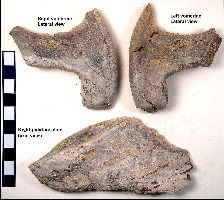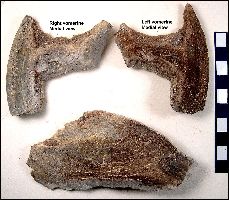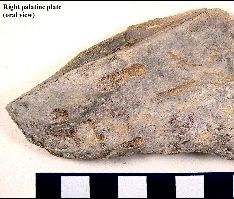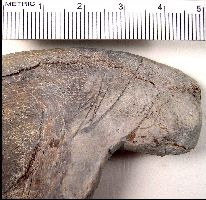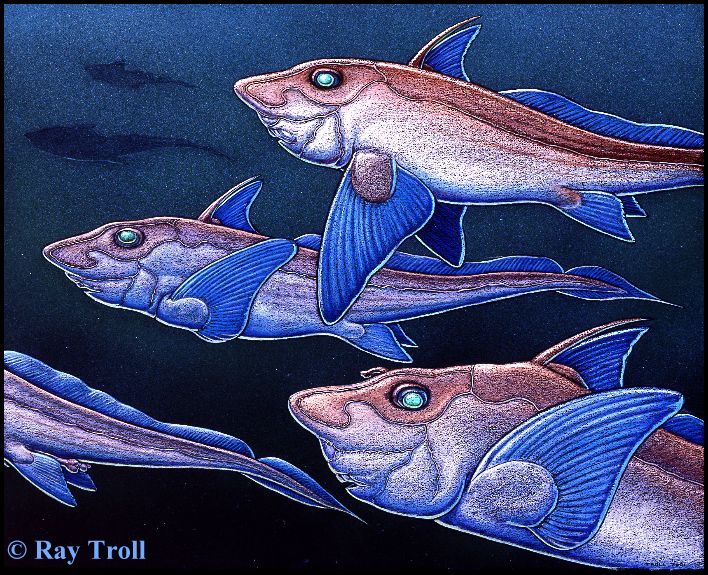 |
Chimaeroids (Ratfishes)
A new taxon of cartilaginous fish from the Smoky Hill
Chalk
Copyright
© 2006-2010
by
Mike Everhart
Page
created 08/26/2006
Last
updated 02/24/2010
LEFT: Hydrolagis trolli painting by Ray Troll,
a newly named species of modern ratfish from New Caledonia. © Ray
Troll, used with permission. Read more about this new species on TrollArt.com |
PUBLICATION (March, 2008):
Cicimurri,
D. J., D. C. Parris and M. J. Everhart. 2008. Partial dentition of a chimaeroid fish
(Chondrichthyes, Holocephali) from the Upper Cretaceous Niobrara Chalk of Kansas, USA. Journal of Vertebrate Paleontology 28(1):34–40.
Although there have been many species of chimaeroids around since the Triassic,
their remains are relatively rare in the fossil record. Chimaeroids are cartilaginous
fish, closely related to sharks, and thus most chimaeroid remains are limited to teeth
(tritors), dorsal fin spines and paired jaw plates. Ratfish
have three pairs of jaw plates (vomerines, palatines and mandibulars). Although the
jaw plates (see below) appear to be bone, they are actually composed of well-calcified
cartilage. The "teeth" (tritors) on these jaw plates are composed of even
tougher hypermineralized cartilage. Modern ratfishes use their crushing dentition to feed
on hard shelled prey. Example of a modern ratfish: Chimaera monstrosa – Linnaeus 1758
(Rabbit fish). Go here for more
information about modern chimaeroids: Dr. Dominique Dagit
Systematics
Phylum:
Chordata
Class:
Chondrichthyes Huxley, 1880
Superorder:
Holocephali Bonaparte, 1832
Order:
Chimaeriformes Obruchev, 1953
Family Callorhynchidae Garman, 1901
Subfamily:
Edaphodontinae Stahl 1999
Edaphodon
laqueatus |
THE SMOKY HILL CHALK CHIMAEROID
The
remains of FHSM VP-16685 were recently collected from the Smoky Hill Chalk and
were identified first by Ken Carpenter (Denver Museum of Nature and Science) in
August, 2006. They were also independently identified a couple of days later by David
Parris (New Jersey Museum of Natural History) and David Cicimurri (Bob Campbell Geology
Museum, Clemson University). Based on a comparison with the type specimen of Edaphodon laqueatus (Leidy 1873 - see
below) in the Academy of Natural Sciences of Philadelphia, we now believe the two
individuals are closely related.
|
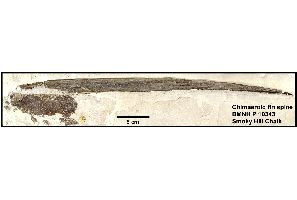 |
LEFT: FHSM VP-16685 is only the second known remains of a ratfish
(chimaeroid) from the Smoky Hill Chalk. The first, a large, dorsal fin spine (BMNH P 10343), was collected by English
immigrant H.T. Martin along Hackberry Creek in Gove County about 1900, and was acquired by
the British Museum of Natural History (see also
Stahl, 1999, fig. 143). The fin spine is approximately 45 cm (18 in) long. This
specimen was collected within ten miles of the FHSM VP-16685 material and at approximately
the same horizon. (Photo credit: British Museum of Natural History, London). Note
that Handel Tong (H.T.) Martin
worked for many years as a collector for the University of Kansas Museum of Natural
History and was the preparator of the type specimen of Dolichorhynchops osborni
(KUVP 1300). |
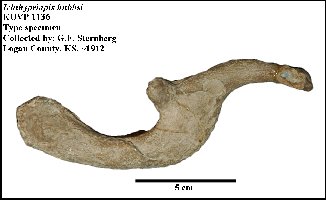 |
LEFT: KUVP 1136 - Ichthypriapis hubbsi; A chimaeroid
clasper described by Hibbard in 1942
(Figs. 1-4). The specimen was collected by G.F. Sternberg in Logan County about
1912. It had been associated with a specimen of Protosphyraena gladius (KUVP
465), but remained unidentified until Hibbard decided it was probably part of a
chimaeroid. Adapted from a photo by Matt Friedman. |
| RIGHT: Figure 21 and 22 of Plate XIX modified from Leidy 1873
showing a medial view (21) and an occlusal view (22) of the right volmerine of the
type specimen of Edaphodon laqueatus (ANSP 5324). The specimen was discovered by
Dr. William Spillman of Columbus, Mississippi. See Manning (1994) for a biography of
Dr. Spillman. Leidy's original name for the specimen was Eumylodus laqueatus
but it was later "lumped" into Edaphodon. A more recent photo is HERE Leidy's caption
for these figures reads:
Fig. 21, 22. Eumylodus laqueatus: Mandible [vomerine] two-thirds
natural size. From the Cretaceous formation of Mississippi, discovered by William
Spillman. |
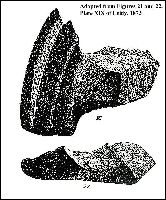 |
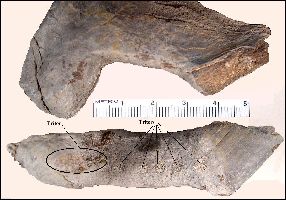 |
LEFT: Top - Close up of the left vomerine in lateral view. Note
that only 4 small, circular tritors were found on the left vomerine (five on the right). Bottom:
A close-up of the right vomerine of FHSM
VP-16685 showing five circular patches where the tritors were originally attached
to this tooth plate. The oval outline indicates the larger and anteriormost tritor on the
beak of the vomerine.
(Scale = mm) |
Credits: Copy of figures from Leidy 1873 provided by Earl Manning.
Other
Oceans of Kansas webpages on Late Cretaceous fish:
Field Guide to Sharks and Bony
Fish of the Smoky Hill Chalk
Sharks:
Kansas Shark Teeth
Cretoxyrhina and Squalicorax
Ptychodus
Chimaerids
Bony Fish
Pycnodonts and Hadrodus
Plethodids:
Pentanogmius
Martinichthys
Thryptodus
Bonnerichthys
Protosphyraena
Enchodus
Cimolichthys
Pachyrhizodus
Saurodon and Saurocephalus
Xiphactinus
SUGGESTED REFERENCES:
Cicimurri,
D. J., D. C. Parris and M. J. Everhart. 2008. Partial dentition of a chimaeroid fish
(Chondrichthyes, Holocephali) from the Upper Cretaceous Niobrara Chalk of Kansas, USA. Journal of Vertebrate Paleontology 28(1):34–40.
Cope, E.D. 1875. The vertebrata of the Cretaceous formations of the
West. Report, U. S. Geological Survey Territory (Hayden). 2:302 p, 57 pls. (see pages
281-293 for descriptions of several chimaeroids, mostly from the east coast)
Duffin, C.J. 1996. Holocephalans in the Staatliches Museum für Naturkunde in
Stuttgart: 4. The earliest German chimeroid. Stuttgarter Beitr. Naturk. Ser. B., Nr. 240,
10 pp., 4 fig.
Duffin, C.J.
2001. A chimaerid (Holocephali, Chimaeriformes) vomerine
toothplate from the Upper Cretaceous of Belgium. Palaeontology, 44(6)1179-1188.
Hibbard, C.W. 1942 A new chimaeroid fish from the
Niobrara Cretaceous of Logan County, Kansas. University Kansas Science
Bulletin 28-2(11):237-240, 4 fig.
Hoganson, J.W. and Erickson, J.M. 2005. A new species of Ischyodus
(Chondrichthyes: Holocephali: Callorhynchidae) from Upper Maastrichtian shallow marine
facies of the Fox Hills and Hell Creek formations, Williston Basin, North Dakota, USA.
Palaeontology 48(4), 709-721.
Hussakof, L. 1912. The Cretaceous chimaeroids of North America. Bulletin of the
American Museum of Natural History 31: 195-228.
Leidy, J. 1873. Contributions to the extinct vertebrate fauna of the western interior
territories. Rept., U.S. Geological Survey Territories (Hayden) 1:358 pp., 37 pls.
Manning, E. M. 1994. Dr. William Spillman (1806-1886), pioneer paleontologist of
Mississippi. Mississippi Geology. 15(4):64-69.
Parmley, D. and Cicimurri, D.J. 2005. First record of a chimaeroid fish from the Eocene
of the southeastern United States. Journal of Paleontology 79(6): 1219-1221.
Stahl, B.J. 1999. Chondrichthyes III.
Holocephali. Handbook of Paleoichthyology 4. Verlag Dr. Friedrich Pfeil, Munich. 164 p.
Stahl, B.J. and Parris, D.C. 2004. The
complete dentition of Edaphodon mirificus (Chondrichthyes: Holocephali) from a
single individual. Journal of Paleontology 78(2), 388-392.
BACK TO INDEX




